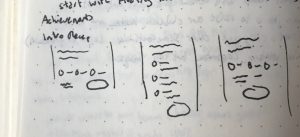When I started seriously thinking about Six Ages, I decided I didn’t want to have difficulty levels.
This is partly because King of Dragon Pass didn’t do a particularly good job with them. The hardest setting was certainly harder than the easiest one, but I think calling the easiest one “Easy” was a mistake. The game itself wasn’t particularly easy, and if a player thought they were experienced at similar games, they might try a harder setting and become frustrated. (I changed the labels to begin at “Normal” as part of the version 2.0 reworking, to clarify this.) And the effects of the settings weren’t explained. In general, King of Dragon Pass stays immersive and doesn’t mention game terms, but this is before play begins.
Even if they had been explained, it’s one more thing to decide before you get to the meat of the game.
So my plan was to focus on tuning the game, and make sure that was right.
Then I asked Ken Rolston to give some feedback on the latest Six Ages build. One of his key items was that he missed KoDP’s difficulty options at the beginning of a new game.
We had a short discussion about this, since Ken said, “when working with Raphael van Lierop on The Long Dark, the single most important thing I worked on was persuading Raphael to add difficulty levels.” I’m pretty sure Ken made many other contributions, but at the very least I needed to reconsider my design.
Certainly difficulty levels are a simple way to accommodate players of different skill. They also hint at replayability (your future self after winning is likely to be at a different skill level, so you might want to try a more challenging level). And while Ken didn’t say this, if he missed difficulty levels, other players might as well. Starting players off with even a minor disappointment isn’t the best experience!
So I will be adding three levels of difficulty: Normal (since this is how I expect people will play), Hard, and Harsh.
I haven’t figured out exactly what these mean, but the basic idea is that Hard will make careful resource management more important, and Harsh may feel like all Glorantha is against you. The game system has a lot of difficulty levers, including
- starting resources
- likelihood of raiding
- level of external threats (e.g. Undead and Chaos in KoDP)
- harvest quality
- various parameters for adaptive difficulty
 I want to show an explanation of the chosen difficulty, so I mocked up a couple UI designs. Now that it’s in the game, I may further tweak the intro (because it is indeed one more choice, and takes up space on a screen that may make other items less prominent).
I want to show an explanation of the chosen difficulty, so I mocked up a couple UI designs. Now that it’s in the game, I may further tweak the intro (because it is indeed one more choice, and takes up space on a screen that may make other items less prominent).
And I’ll start adjusting things to see how big a difference it makes.
 We’ve been working with Stan LePard (who did the music for King of Dragon Pass) on music and sound effects for some time, but it was only this week that he delivered them all in a form that’s playable with our sound engine (Wwise).
We’ve been working with Stan LePard (who did the music for King of Dragon Pass) on music and sound effects for some time, but it was only this week that he delivered them all in a form that’s playable with our sound engine (Wwise). I want to show an explanation of the chosen difficulty, so I mocked up a couple UI designs. Now that it’s in the game, I may further tweak the intro (because it is indeed one more choice, and takes up space on a screen that may make other items less prominent).
I want to show an explanation of the chosen difficulty, so I mocked up a couple UI designs. Now that it’s in the game, I may further tweak the intro (because it is indeed one more choice, and takes up space on a screen that may make other items less prominent).